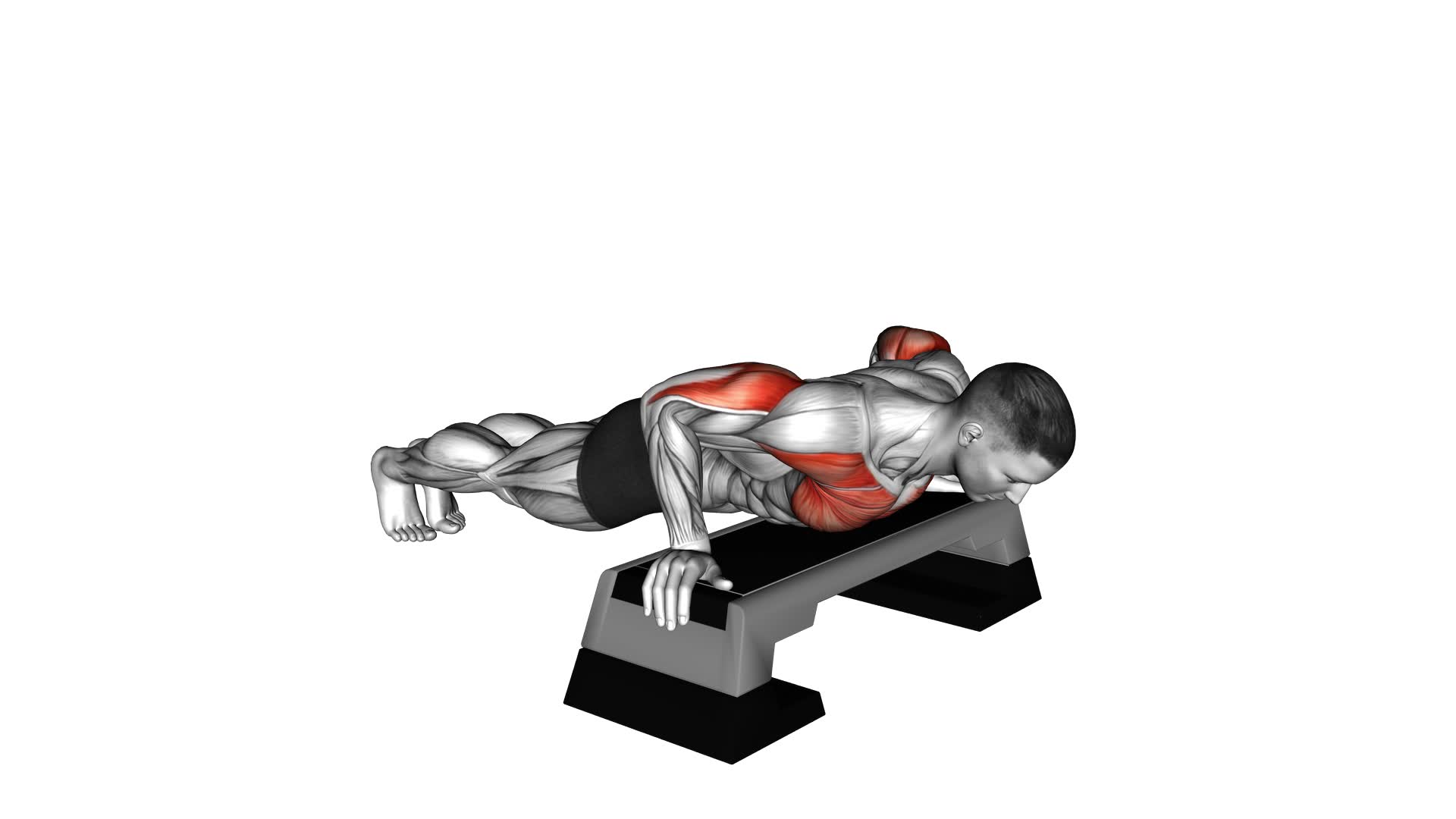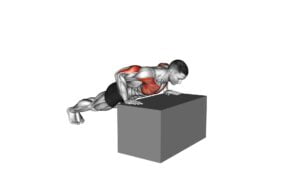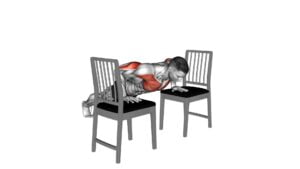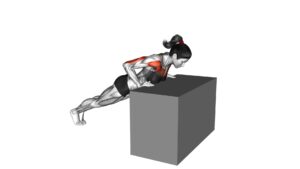Incline Push-up – Video Exercise Guide & Tips

Are you looking to level up your push-up game? Incline push-ups might be just what you need.
Watch This Exercise Video
This video exercise guide and tips article will show you the benefits of incline push-ups, proper form, equipment needed, variations, common mistakes to avoid, and tips for progressing.
Get ready to strengthen your upper body and core with this effective and versatile exercise.
Let's get started!
Key Takeaways
- Incline push-ups target upper body muscles and engage multiple muscle groups in the upper body and core.
- Incline push-ups are a scalable exercise for all fitness levels and a safer alternative for individuals with wrist or shoulder issues.
- Proper form and technique include keeping elbows at a 45-degree angle, focusing on breathing, maintaining steady and controlled movement, and tucking elbows in towards the body.
- Breathing techniques that synchronize breath with movements help stabilize the core, engage necessary muscles, and maximize efficiency and performance during the exercise.
Benefits of Incline Push-ups
You can reap numerous benefits from incorporating incline push-ups into your workout routine. Incline push-ups primarily target the muscles of your upper body, including the chest, shoulders, and triceps. By performing this exercise on an inclined surface, you increase the workload on these muscles, making them work harder and promoting strength gains.
Incorporating incline push-ups into a full body workout routine can be highly effective. Not only do they engage multiple muscle groups in your upper body, but they also activate your core muscles, providing stability and balance. This exercise can be a great addition to your routine, whether you're a beginner or an advanced fitness enthusiast.
Another benefit of incline push-ups is that they're a scalable exercise. You can easily adjust the difficulty level by changing the angle of the incline or the height of the surface. This allows you to challenge yourself and progress over time as you get stronger.
Incline push-ups also offer a safer alternative to traditional push-ups for individuals with wrist or shoulder issues. By performing the exercise on an inclined surface, you can reduce the strain on these joints while still reaping the benefits of a pushing movement.
Proper Form for Incline Push-ups
To perform incline push-ups with proper form, it's important to pay attention to your elbows position. Keep them close to your body and at a 45-degree angle to maximize the effectiveness of the exercise.
Additionally, focus on your breathing during incline push-ups, exhaling as you push up and inhaling as you lower yourself down.
Elbows Position for Incline Push-Ups
Maintain a steady and controlled movement by keeping your elbows tucked in towards your body during incline push-ups. Proper elbow alignment is essential to prevent strain and ensure that you're targeting the correct muscles. Here are three key points to remember:
- Elbows should be at a 45-degree angle to your body: This position helps engage your chest muscles and reduces stress on your shoulders.
- Avoid locking your elbows: Keeping a slight bend in your elbows throughout the exercise helps maintain tension in your muscles and prevents unnecessary strain.
- Don't let your elbows flare out: If your elbows move away from your body, you may experience elbow pain during push-ups. Keep them close to your sides to maintain proper form.
By following these guidelines, you can perform incline push-ups effectively and without discomfort.
Now let's move on to the next important aspect: breathing during incline push-ups.
Breathing During Incline Push-Ups
As you transition into the topic of breathing during incline push-ups, it's important to focus on maintaining proper form for optimal results. Proper breathing techniques play a crucial role in maximizing muscle activation and enhancing your overall performance during this exercise.
When performing incline push-ups, inhale deeply as you lower your body towards the bench, and exhale forcefully as you push yourself back up. This controlled breathing pattern helps stabilize your core and engage the necessary muscles for a more effective workout.
By synchronizing your breath with your movements, you can increase the efficiency of your incline push-ups and promote better muscle activation.
Now that you understand the significance of breathing, let's move on to discussing the equipment needed for incline push-ups.
Equipment Needed for Incline Push-ups
You will need equipment for performing incline push-ups. Here are three items that you can use to enhance your incline push-up workout:
- Incline Bench: An incline bench is the most common equipment used for incline push-ups. It's a sturdy bench with an adjustable incline that allows you to set the height according to your fitness level. The incline bench provides stability and support, making it easier to perform the exercise.
- Stability Ball: If you don't have an incline bench, a stability ball can be a great alternative. Place your hands on the ball, keeping it stable as you perform the push-ups. The unstable surface of the stability ball engages your core muscles and adds an extra challenge to the exercise.
- Plyo Box: A plyo box is another option for performing incline push-ups. It's a sturdy platform with different height options. Adjust the height of the plyo box to find your ideal incline height. The plyo box provides stability and allows you to target different muscle groups by adjusting the incline.
Using any of these equipment options will help you modify your incline push-ups and find the ideal incline height that suits your fitness level. Remember to choose the equipment that feels comfortable and allows you to maintain proper form throughout the exercise.
Variations of Incline Push-ups
To add variety to your incline push-up routine, try incorporating different variations of the exercise using the equipment mentioned earlier.
These variations can help you progress and challenge different muscle groups.
One variation you can try is the decline push-up, where your feet are elevated on a bench or step, while your hands are on the ground. This variation increases the activation of your upper chest and shoulders.
Another variation is the wide grip incline push-up, where your hands are placed wider than shoulder-width apart on the bench or step. This targets your chest muscles more intensely.
If you want to focus on your triceps, you can do close grip incline push-ups by placing your hands close together on the bench or step. This variation emphasizes the triceps muscles.
Lastly, you can try the one-arm incline push-up by placing one hand on the bench or step and the other hand behind your back. This variation challenges your chest and core stability.
Incorporating these variations into your incline push-up routine will help you progress and activate different muscle groups effectively.
Common Mistakes to Avoid
When performing incline push-ups, it's important to avoid two common mistakes: having your elbows too wide and sagging your lower back.
Keeping your elbows close to your body helps to engage the chest muscles more effectively and prevents strain on the shoulders.
Additionally, maintaining a straight line from your head to your heels ensures proper form and maximizes the benefits of the exercise.
Elbows Too Wide
Incorrect elbow positioning is a common mistake to avoid during incline push-ups. When your elbows are too wide, it can negatively impact your form and compromise your shoulder stability. Here are three reasons why you should pay attention to your elbow alignment during incline push-ups:
- Proper shoulder stability: Keeping your elbows slightly tucked in helps to engage the muscles around your shoulder joint, promoting stability and reducing the risk of injury.
- Improved triceps activation: When your elbows are closer to your body, it allows for better activation of the triceps muscles, leading to more effective strength gains in the back of your arms.
- Engagement of chest muscles: By aligning your elbows with your shoulders, you ensure that your chest muscles are properly engaged throughout the exercise, maximizing the benefits of the incline push-up.
Sagging Lower Back
To avoid sagging your lower back during incline push-ups, make sure to maintain a strong and stable core. This is crucial for proper form and preventing lower back pain.
When your core is weak or not engaged, your lower back tends to collapse and sag, putting unnecessary strain on the spine. To prevent this, focus on engaging your abdominal muscles and keeping your hips in line with your spine throughout the exercise.
Additionally, consider modifying the incline push-up by reducing the angle or using a higher surface for support. This can help alleviate pressure on the lower back and make the exercise more manageable.
Tips for Progressing With Incline Push-Ups
To progress with incline push-ups, challenge yourself by gradually increasing the height of the surface you're using. This will help to increase the difficulty of the exercise and further engage your muscles.
Here are three tips for progressing with incline push-ups:
- Increase the height incrementally: Start with a surface that's comfortable for you, such as a bench or a step. As you become stronger, gradually increase the height by adding more steps or using a higher platform. This will challenge your muscles and allow for progression over time.
- Maintain proper form: As you increase the height, it's important to focus on maintaining proper form throughout the exercise. Keep your core engaged, shoulders back and down, and elbows tucked in. This will ensure that you're activating the correct muscles and avoiding any unnecessary strain or injury.
- Gradually decrease the incline: Once you have mastered a certain height, you can begin to decrease the incline and move closer to the ground. This will further increase the difficulty and continue to challenge your muscles. Eventually, you'll be able to perform full push-ups on the ground.
Frequently Asked Questions
Are Incline Push-Ups Suitable for Beginners?
Incline push-ups can be a great starting point for beginners. They allow you to gradually build strength in your upper body without putting too much strain on your wrists and shoulders.
By starting with a higher incline and gradually decreasing it over time, you can progress to doing regular push-ups on the floor. This exercise targets your chest, shoulders, and triceps, helping you develop upper body strength.
Incorporating incline push-ups into your routine can lead to significant improvements in your overall fitness.
Can Incline Push-Ups Help in Building Chest Muscles?
Incline push-ups are a great way to build your chest muscles. By incorporating incline push-ups into your workout routine, you can experience several benefits.
They target your upper chest and shoulders while also engaging your triceps and core.
To progress from incline push-ups to regular push-ups for further chest muscle development, gradually lower the incline until you can perform push-ups on the floor.
Remember to maintain proper form and gradually increase the intensity of your workouts for optimal results.
How Many Sets and Repetitions Should I Do for Incline Push-Ups?
To determine how many sets and repetitions you should do for incline push-ups, it's important to consider the benefits of incorporating them into your full body workout routine.
Incline push-ups can help strengthen your chest muscles and improve upper body strength.
To progressively increase the difficulty and promote continued muscle growth, you can start with a manageable number of sets and reps, and gradually increase the intensity over time.
This will ensure that you challenge your muscles and see progress in your fitness journey.
Can Incline Push-Ups Help in Improving Posture?
Incline push-ups can be effective in improving your posture. By engaging your core and upper back muscles, this exercise helps to strengthen the muscles responsible for maintaining good posture.
In addition, incline push-ups also contribute to overall fitness by targeting your chest, shoulders, and triceps.
Incorporating these posture correction exercises into your routine can have long-term benefits for your posture and overall fitness.
Are Incline Push-Ups More Effective Than Regular Push-Ups for Targeting Specific Muscle Groups?
Incline push-ups can be more effective than regular push-ups for targeting specific muscle groups. By adjusting the angle of your body, you can vary the intensity and focus on different areas.
For example, an incline push-up targets the upper chest and shoulders more than a regular push-up. Adding variations like raising your feet on a bench or using a stability ball can further increase the challenge and target specific muscle groups.
Conclusion
Incline push-ups are a great exercise for targeting the upper body muscles, especially the chest, shoulders, and triceps. By adjusting the angle of the body, individuals can modify the intensity of the exercise to suit their fitness level.
It's important to maintain proper form to maximize the benefits and avoid injury. With consistent practice and progression, incline push-ups can help individuals build strength and improve their overall fitness.

Author
Years ago, the spark of my life’s passion ignited in my mind the moment I stepped into the local gym for the first time. The inaugural bead of perspiration, the initial endeavor, the very first surge of endorphins, and a sense of pride that washed over me post-workout marked the beginning of my deep-seated interest in strength sports, fitness, and sports nutrition. This very curiosity blossomed rapidly into a profound fascination, propelling me to earn a Master’s degree in Physical Education from the Academy of Physical Education in Krakow, followed by a Sports Manager diploma from the Jagiellonian University. My journey of growth led me to gain more specialized qualifications, such as being a certified personal trainer with a focus on sports dietetics, a lifeguard, and an instructor for wellness and corrective gymnastics. Theoretical knowledge paired seamlessly with practical experience, reinforcing my belief that the transformation of individuals under my guidance was also a reflection of my personal growth. This belief holds true even today. Each day, I strive to push the boundaries and explore new realms. These realms gently elevate me to greater heights. The unique combination of passion for my field and the continuous quest for growth fuels my drive to break new ground.







